History of the Astronomy Centre
The Early Years
Astronomy at Sussex started in October 1965, with the beginning of a formal collaboration between the University and the Royal Greenwich Observatory, then at Herstmonceux; this collaboration lasted almost 25 years, until the RGO moved to Cambridge. The first astronomers in post were three visiting staff from RGO: the Astronomer Royal, Sir Richard Woolley, was made a visiting professor and there were two visiting readers – Donald Lynden-Bell and Bernard Pagel. The MSc programme also started in October 1965, despite there being no astronomers in post at Sussex: the courses were planned and delivered by the visiting staff and by professors in the then School of Mathematical and Physical Sciences (MAPS), such as Roger Blin-Stoyle, Douglas Brewer and Ken Smith from Physics and Gilford Ward from Mathematics. Two lecturers in Mathematics, Frank Clifford and Michael Cummings, held doctorates in astronomy and were also involved in teaching in the first few years. In 1965-66, all the MSc students were members of RGO staff, studying part-time, so the first graduates were in 1967. From October 1966 there were also full-time students (one of whom was John Gribbin, now a well-known science writer and a Visiting Fellow at Sussex) and there were typically four research council studentships for MSc students every year until 1996-97, after which PPARC withdrew funding for all Astronomy MSc programmes in the UK. Nonetheless, the MSc course has continued to survive to the present day, and now has two strands: Cosmology (introduced in 2003) and Astronomy; since 2003, there have been 38 Astronomy graduates and 33 Cosmology graduates.
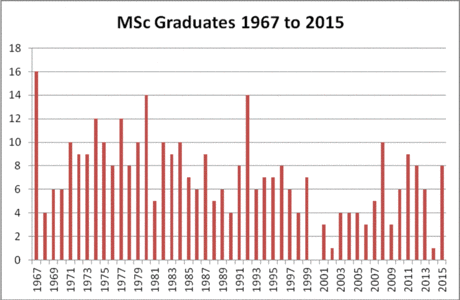
By the end of 2014-15 there had been a total of 347 MSc graduates, an average of 7 per year since 1967. Numbers in a particular year range widely from 0 (in 2000) to 16 (in 1967) (see figure above). In addition there have been 9 students who withdrew from the course (one on ill-health grounds, after an accident) and 11 who failed (although one subsequently successfully completed a PhD elsewhere). Two recent students obtained passes in the Postgraduate Certificate, making a total of 369 students who have taken part in the course. 26 students were part-time. The official designation of ‘with distinction’ was introduced in 1991, and ‘with merit’ in 2006; 31 distinctions and 28 merits have been awarded. Prior to 1991, candidates who did particularly well in the written examination were said to have passed ‘with special merit’, but this was not reflected on their degree certificates, nor is it consistently recorded in the exam board minutes in the Record Book (begun by Roger Tayler).
Of course, the collaboration with the RGO was based on the promise that there would be astronomy faculty at Sussex, and the first Professor was William McCrea (later Sir William), who moved from being Head of the Department of Mathematics at Royal Holloway College. He arrived part-time in January 1966 and became full-time later that year. However, he was a research professor, leading a small research group funded by the Science Research Council (the 'E' in SERC was added later); other members were Ian Roxburgh (1966-67; now Emeritus Professor at QMUL) and John Hazlehurst (1967-73; now Emeritus Professor at Hamburg). The first university-funded professor was Roger Tayler, appointed in 1966 and taking a full part in planning from May 1966; he moved from Cambridge to Sussex in April 1967 and played an important role in the leadership of the Astronomy Centre until his untimely death in January 1997. In November 1996 he published a booklet, which forms the basis for this section, recording the first Thirty Years of Astronomy at Sussex. At that stage there had been 103 DPhil graduates and 1 MPhil graduate; this has now grown (by December 2015) to 163 DPhil and 4 MPhil graduates.
The collaboration with the RGO extended to research students and research fellows, with observational students being supervised by RGO staff, who included Richard Bingham, Bob Dickens, Dianne Harmer, Derek Jones, Paul Murdin, Andrew Murray, Michael Penston and Jasper Wall as well as several RGO-appointed research fellows. From the mid-1970s, a joint research grant was held by the RGO and Sussex to support observational fellows, who shared their time between the sites. One of these, David Axon, became in 2009 the first Head of the current School of Mathematical and Physical Sciences (MPS), until his sudden unexpected death in April 2012. Joint seminars were also held, usually at Sussex but once a month at RGO (where the present custom of drinks after the seminar originated, allegedly initially to use up a store of drinks left behind by the Burbidges). As a result of Robert Smith turning to observational astronomy in 1985, in collaboration with RGO staff, the observational influence on the Astronomy Centre survived the RGO's move to Cambridge, with a Starlink computer node being installed at Sussex in July 1990. This was the forerunner of the present research computer network, which supports both astronomy and theoretical particle physics.
On the retirement of McCrea in 1972, Martin Rees was appointed as his successor (aged 30, but already with more than 70 publications); however, he was soon appointed to the Plumian Chair in Cambridge (vacated when Hoyle left Cambridge), and Leon Mestel succeeded him in October 1973. By that time John Hazlehurst had departed to a chair in Hamburg and was succeeded in 1973 by Robert Smith, previously (1968-72) part of the McCrea research team, then a temporary lecturer (1972-73). No further new permanent appointments were made until John Barrow came in 1981, although Nigel Holloway held a temporary lectureship from 1974-80 and John Jackson was a Tutorial Fellow from 1968-70. Peter Thomas was appointed to a permanent post in 1989 when Mestel took early retirement, maintaining the total of permanent astronomy staff at the university at four.
Later Developments – teaching
The Astronomy Centre was a separate subject group until 1989, when it merged with Physics and became a research group within the Physics and Astronomy Subject Group (from 2003 the Department of Physics and Astronomy). However, it had already introduced an increasing number of undergraduate modules and degree courses, a development followed later by many other departments in England (astronomy degrees were already widespread in Scotland). It was amongst the first universities in England to develop full undergraduate programmes in astronomy. Tayler published in the 1970s two influential undergraduate texts, on stars and on galaxies; in the 1990s, Smith and Andrew Liddle also published textbooks, on observational astrophysics and on cosmology, respectively. A new undergraduate degree in Physics with Astrophysics was introduced in 1990, which extended astronomy teaching to the first year and included practical laboratories in astronomy for the first time, initially just in the first year. This degree was later supplemented by an Astrophysics degree, with more compulsory astronomy modules. At postgraduate level, the original MSc in Astronomy was joined in 2003 by an MSc in Cosmology, as noted above. There has been a gradual evolution of modules and course structures since then.
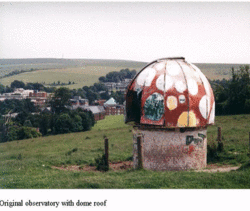
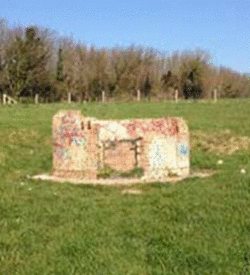
Practical projects for final-year students, using telescopes on campus, had already begun in the 1970s, although the original campus telescope behind Park Village was closed in 1988 after a serious theft and increasing incidents of vandalism. A picture of that telescope in the late 1970s can be seen here. The photographs on the left shows the observatory in daylight; the ‘magic mushroom’ design was painted by one of the vandals during the 1980s. The picture on the right shows the partially demolished observatory in 2012; trees in background are on ridge over to Stanmer Park.
In September 1996, an off-site observatory, with an 18-inch telescope (originally owned by the keen amateur astronomer and professional engineer Harold (‘Dick’) Robin, from Tunbridge Wells), was opened by Alex Boksenberg at the Isle of Thorns, at Chelwood Gate in East Sussex, then the University's Conference Centre but now (since 2001) the national headquarters of Cats Protection. This telescope has been used for final-year undergraduate projects, and in 2002 two project students constructed a website, now rather out of date but still useful as an introduction for new project students. The photographs below show the telescope in 1996 (with Dick Robin) and in 2014, taken by one of the project students.
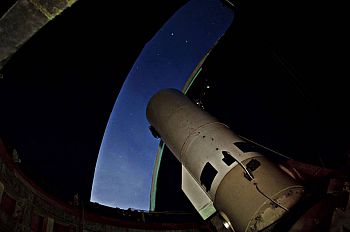
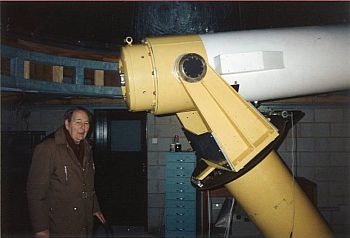
In addition, roof-top telescopes were installed on campus. The first (in the early 1990s) was an 8-inch Meade, situated on the roof of Pevensey I, immediately above the Astrophysics Lab; thanks to the ingenuity and skill of Mike Hardiman and Barry Farmery, this telescope was mounted on a platform which could be raised through the roof when required for observation. It was also used within the lab for teaching students about telescopes. The photographs show it with some of the project students.
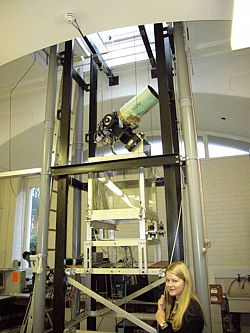 |
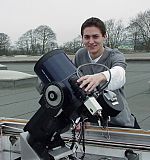 |
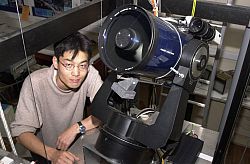 |
Later, the department lost that space to Psychology and a new 10-inch Meade was purchased, and installed permanently on the roof of Pevensey II in 2009, above the MPhys lab, where it is used both for MPhys lab teaching and for final-year projects. Several published papers have been produced from project work on the first two of these telescopes.
Later Developments – research
Despite its small size for much of its history, the Sussex Astronomy Centre has exerted a considerable influence on astronomy around the world. This is in part because of the quality of the early professorial appointments (McCrea, Tayler, Rees, Mestel) and the strong link with RGO staff (especially Jones, Lynden-Bell, Pagel and Penston), and in part because of the large number of graduates from its MSc and DPhil programmes. Many research fellows have also been involved over the years (Tayler’s history lists 69 from 1966 to 1996). Many of the graduate students and fellows now hold senior academic and other positions in astronomy all over the world.
Until the appointment of John Barrow, the main emphasis of research in astronomy was on stellar physics, particularly on the effects of rotation (Mestel, Smith), magnetic fields (Tayler, Mestel and Holloway) and binarity, especially contact binaries (Hazlehurst, Smith and temporary lecturer Alistair Robertson), with McCrea working primarily on solar system topics but also on cosmology. Tayler extended work begun in Cambridge on cosmology and the influence of fundamental particles, notably the importance of the half-life of the neutron, whose experimental value was being precisely measured at Sussex in the early 1970s. Smith began working on cataclysmic variable stars in the early 1980s, and transferred to largely observational work in about 1985, in collaboration with Derek Jones at RGO and later with temporary lecturers Paul Roche (1994-March 1999) and Pierre Maxted (1995-96). Work on stellar evolution flourished during the tenure of another temporary lectureship by Klaus-Peter Schröder from January 2000 to August 2005.
With Barrow’s appointment, work on extragalactic and cosmological topics became more important; later, Thomas worked on clusters of galaxies and large-scale numerical simulations and Tayler worked latterly mainly on the chemical evolution of our Galaxy. Thomas’s appointment in 1989 marked the beginning of a series of new appointments in astronomy: Andrew Cameron (1990-94; research fellow 1987-90), Andrew Liddle (1994-99; research fellow 1989-94) and Carole Haswell (February 1996-March 1999).
When Barrow moved to Cambridge in 1999, Andrew Liddle was appointed in 2000 (after a year at Imperial College, London) to replace him and subsequently built up a research group whose emphasis is on the theory and observation of clusters of galaxies, on galaxy formation and on many areas of theoretical and observational cosmology. The group has many international collaborators and is involved in several key space missions. Liddle took up a chair in Edinburgh in 2012, but other staff have been appointed both while Liddle was here and after his departure. The permanent faculty now (end of 2015) consists of four professors and nine other academic staff (this includes the Head of School, Professor Peter Coles, and a theoretical physicist with strong interests in cosmology, but excludes Emeritus Reader Robert Smith), making the Astronomy Centre stronger than it has been at any other time in its history. The current faculty list can be found using this link.
In keeping with the modern trend in astronomy for large-scale projects tackling major identified challenges, the group is now characterized by a wide range of involvements in different projects, both theoretical and observational and normally on an international scale. They target some of the most fundamental questions in science: how did the Universe begin, how does it evolve and what is its material composition, and when and how did galaxies form?
Within the global effort on these topics, each group has its own niche. The observational focus is on multi-wavelength survey astronomy, where information from many telescopes sensitive to different types of radiation (for instance infra-red and X-ray) is combined to study how different physical mechanisms interact. On the theoretical side, the Centre combines expertise in advanced data analysis techniques with the application of high-performance computing to astrophysical problems. For instance, Sussex researchers have been involved in the largest-ever cosmological simulations, tracking the evolution of over one hundred billion particles using a supercomputer with more than 20,000 independent processors.
Exploitation of data from satellite missions has become a major activity at Sussex, with direct faculty involvement in many of the currently active missions. They study the largest objects in the Universe, great clusters of galaxies held together by their mutual gravity, using the European Space Agency (ESA) satellite XMM-Newton. With NASA’s Spitzer satellite and ESA’s Herschel satellite, infra-red radiation is being used to track the history of the formation of stars in galaxies young and old. They are also uncovering the nature of the Big Bang itself from its microwave emission observed with ESA’s Planck Surveyor satellite.
A centrepiece of the current activity is the HerMES project. Led from Sussex by Seb Oliver, this is the largest project on the ESA’s Herschel Satellite, which in 2009 became the largest astronomical telescope ever launched into space. HerMES has discovered hundreds of thousands of distant galaxies, tracing the star-formation history of the Universe from today back over 10 billion years or more into the past. By charting the locations of these star-forming galaxies, and examining the sort of structures they trace, researchers are able to test theories of how galaxies form and evolve.
Organisational aspects
In the summer of 1996, the School of MAPS disappeared as part of a general reorganisation of subjects and schools, and Physics & Astronomy became part of the School of Chemistry, Physics and Environmental Science (CPES). At Christmas of the same year, the subject group received a very poor Research Assessment Exercise result (3a), which followed a similar result in 1992, and was as a result severely constrained financially until the next RAE. Permanent faculty numbers declined sharply in the late 1990s, with teaching and research being supported by significant numbers of active retired or temporary faculty. Although some appointments were made in this period, the departures in 1999 of John Barrow to Cambridge, Carole Haswell to the Open University and Andrew Liddle to Imperial College left Astronomy with only two permanent faculty.
Fortunately, at around this time the new Vice-Chancellor Alasdair Smith took a more positive view of the department than his predecessor. He agreed to seek a new astronomy professor to replace John Barrow, and Andrew Liddle returned to take up the position, starting in January 2000, along with approval to make two further lectureship appointments to bring the group back to five faculty.
This still left the group as one of the smallest in the country, and Liddle took the view that to succeed in an increasingly competitive funding environment, it was necessary for the group to specialise. This meant moving away from some areas of traditional Sussex strength, including stellar astrophysics which was maintained by Smith up to his retirement in 2006 but not continued thereafter by any permanent faculty. The new focus of the group was entirely on extragalactic astrophysics and cosmology, with both theoretical and observational activities. This also brought the group’s work into much better alignment with the funding priorities of the research council (originally PPARC, then STFC).
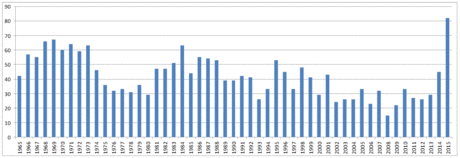
Student numbers
While Astronomy then experienced a period of relative stability, the rest of Physics was still buffeted by departures, in quick succession, of professors from each of the other research groups, but following a good showing (5) in the RAE of 2001 momentum was on the department’s side and it was able to start growing again. The situation was transformed in 2008, with the award of strategic funding from HEFCE for the South-East Physics Network (SEPnet) of six universities; an application for renewal in 2013 was successful, for an expanded network of nine universities. Along with investment from the university, this enabled further new appointments in the department, including the appointment of an Outreach Officer, and these and other factors (such as good results in the National Student Survey) helped to raise the number of students graduating to 82 in 2015, the highest value in the history of the department (see figure below). This in turn has enabled the faculty numbers to be built back to the high thirties (38 full-time permanent staff by December 2015), placing the department in easily its strongest position for more than 30 years. The Astronomy group alone has now grown to eleven full-time faculty, plus two associated staff, and features approximately 60 researchers at all levels from faculty to masters students.
In the meantime, two further reorganisations of the schools in the university have taken place. The School of CPES ended in summer 2003, after a mere 7 years of existence, and was replaced by the larger School of Science & Technology (SciTech), comprising Physics & Astronomy, Mathematics, Engineering & Design and Informatics. Chemistry moved into the other large science school, the School of Life Sciences. These schools were found in practice to be too big, and in summer 2009 they were split up again, with Physics & Astronomy and Mathematics (re-)forming the School of Mathematical and Physical Sciences, now known as MPS.
In 2016 the Centre celebrated its 50th anniversary.
More information about the history of the whole department can be found on the History of Physics wiki at http://history.phys.susx.ac.uk/Main_Page .